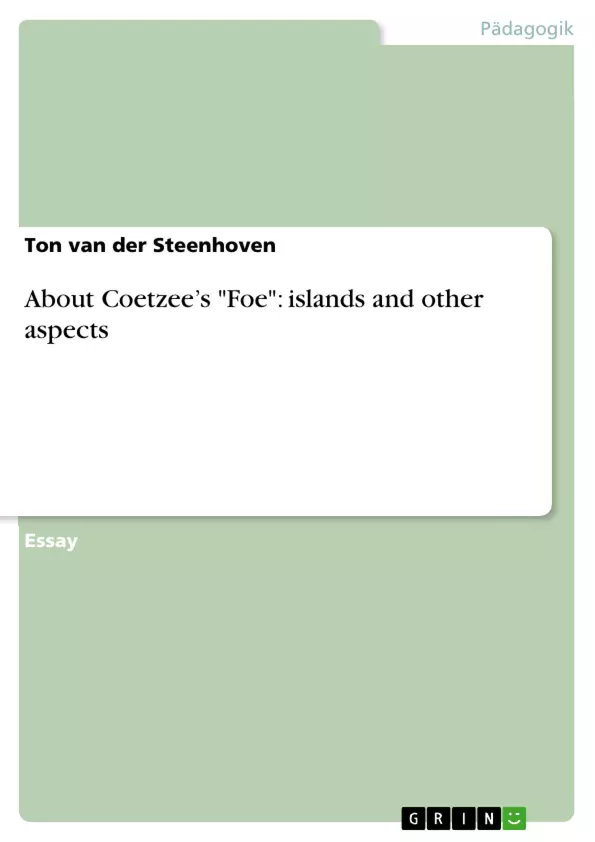The story is written from the perspective of Susan, a castaway on the same island as Cruso and Friday. It’s a story of islands: Cruzo’s island, the ship, Foe’s house, England. In addition the actors are islands too: they are isolated individuals, living in their own world. The result is an almost autistic silence. In this essay, the main characters are described as islands in an archipelago, seperated characters, condemned to each other.
Susan’s story, an oral story, is a central theme in the novel. It becomes gradually clear that she is telling her story to the author Foe. Susan fails in her attempt to produce her story in a book.
Friday is the footprint of Robinson Crusoe and every Robinsonade. Coetzee foregrounds Friday’s silence. By doing so, he undermines the hegemony of the colonial discourse that presupposes European racial superiority.
Friday (black) and Susan (woman) are both colonised subjects by the male colonizing characters, (both male and white): Cruso on his island and Foe, whose trade is in books, not in truth.
Inhaltsverzeichnis
- Coetzee's Foe: islands and other aspects
- The Character of Friday
- The creative process of storytelling
- Susan's way of telling the story
- The three sections of the novel
- The two possible endings
- Friday's position in the novel
- Friday's silence
- Fazit
- Literaturverzeichnis
Zielsetzung und Themenschwerpunkte
Die Endtermpaper analysiert J.M. Coetzees Roman "Foe" (1986) als eine Neuinterpretation von Daniel Defoes "Robinson Crusoe". Der Text untersucht die kolonialen und imperialen Ideologien, die in Defoes Werk verankert sind, und beleuchtet die Rolle von Sprache und Schweigen in der Konstruktion von Machtverhältnissen.
- Die Bedeutung von Sprache und Schweigen in der Kolonialisierung
- Die Dekonstruktion von Geschlechterrollen und Machtstrukturen
- Die Darstellung von Rassismus und Unterdrückung
- Die Rolle des Erzählens und der Kreativität
- Die Bedeutung von Friday's Schweigen
Zusammenfassung der Kapitel
Die Endtermpaper beginnt mit einer Analyse der Unterschiede zwischen Coetzees "Foe" und Defoes "Robinson Crusoe". Der Fokus liegt dabei auf der neuen Perspektive der Erzählerin Susan Barton, die die Geschichte aus einer weiblichen Sicht erzählt und damit die männlich dominierte Perspektive von Defoes Roman untergräbt.
Die Arbeit beleuchtet die Bedeutung von Friday's Charakter und die Darstellung von Rassismus und Kolonialismus in Coetzees Roman. Es wird gezeigt, wie Friday's Schweigen als eine Form des Widerstands gegen die europäischen Machtstrukturen interpretiert werden kann.
Die Endtermpaper analysiert den kreativen Prozess des Erzählens in "Foe" und die Probleme der Produktion von Geschichten. Susan Barton's Bemühungen, ihre Geschichte zu erzählen, werden im Kontext von Gender, Rasse und Kolonialismus betrachtet.
Die Arbeit untersucht die drei Abschnitte des Romans, die jeweils unterschiedliche narrative Strategien und Perspektiven aufweisen. Die Endtermpaper analysiert die beiden möglichen Enden des Romans und die Bedeutung von Friday's Schweigen für die Interpretation des Textes.
Die Endtermpaper untersucht Friday's Position im Roman und die Bedeutung seiner Schweigens. Es wird gezeigt, wie Friday's Schweigen als eine Form des Widerstands gegen die Kontrolle der anderen Charaktere interpretiert werden kann.
Schlüsselwörter
Die Schlüsselwörter und Schwerpunktthemen des Textes umfassen "Foe", "Robinson Crusoe", "Kolonialismus", "Imperialismus", "Sprache", "Schweigen", "Rassismus", "Gender", "Erzählen", "Kreativität", "Friday", "Susan Barton", "Postmoderne". Die Arbeit analysiert die Dekonstruktion von Machtstrukturen und die Bedeutung von Friday's Schweigen in der Konstruktion von Identität und Widerstand.
- Citation du texte
- MA Ton van der Steenhoven (Auteur), 2010, About Coetzee’s "Foe": islands and other aspects, Munich, GRIN Verlag, https://www.grin.com/document/152567



